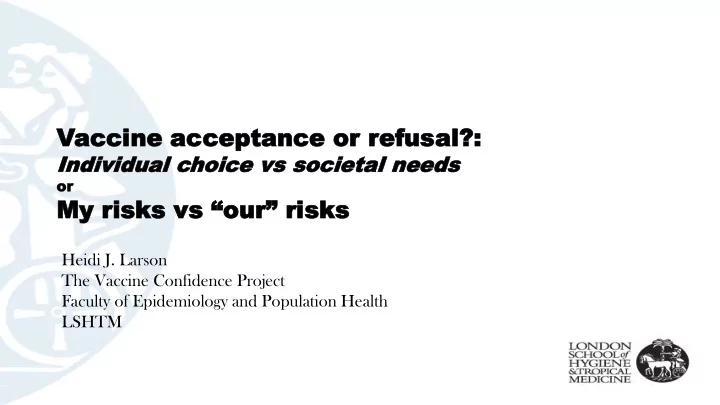

Vaccine accine acceptance or acceptance or refusal?: efusal?: Ind Individu ividual al cho hoice ice vs vs so socie cieta tal l ne need eds or or My risks vs “our” risks Heidi J. Larson The Vaccine Confidence Project Faculty of Epidemiology and Population Health LSHTM
Risk as feelings lings (fast , instinctive, emotional.. ) Risk as analysis (logic, reason, scientific...) Risk as Po Poli litics tics Adapted from Slovic et al. Risk Analysis 2004; 24 (2): 311-22
So what do we need to do?? Scientists (and the Media!) must not to treat fear • and reservation as ignorance and then try to destroy them with a blunt “rational” instrument. Pattison – BMJ 2001;323:838-840
Reasons easons for or vaccine hesitanc vaccine hesitancy and opposition y and opposition In the 19 th Century In the 21 st Century • • Principles were not well understood Principles STILL not well understood • • Perception that vaccination is not needed Vaccination is ineffective. • Concerns about vaccine safety • Vaccination is not safe. • Religious and philosophical concerns • Religious and philosophical concerns. • Resistance to compulsory vaccination • Resistance to compulsory vaccination. Heidi.larson@lshtm.ac.uk
Vac accine cine he hesita sitanc ncy y an and d risk risk pe perce cept ption ion heidi.larson@lshtm.ac.uk
WHO Guidance But what about the perception of safety??
Prompters of questions and risk perceptions • Adverse Event (AEFI) – local AEFI are usually stronger prompters of rumors, but a distant event reported can also spread and provoke questions • New research reported • New recommendation or policy change • New product (introduction of new product or product packaging) Larson/Restoring Public Trust
Perceptions are also about motives http://www.gmofreeglobal.org/en/mission
The role of social media OPPORTUNITY or RISK? Wo Worl rld Economic Forum: rum: Global Risk sks s 2013 Heidi.larson@lshtm.ac.uk
2013 Global Risks Report -World Economic Forum Heidi.larson@lshtm.ac.uk
Report of the Independent Monitoring Board of the Global Polio Eradication Initiative November 2012 Result of 2003-2004 rumour-driven vaccine boycott Heidi.larson@lshtm.ac.uk
Herd immunity or Herd mentality?
Wakefield Lancet Article
Determinants of vaccine hesitancy Understanding vaccine hesitancy around vaccines and vaccination from a global perspective: A systematic review 17 of published literature, 2007-2012. Larson HJ, Jarrett C, Eckersberger E, Smith DM, Paterson P. Vaccine. 2014 Apr 17;32(19):2150-2159.
Articles about vaccine hesitancy by year and WHO region [n = 1164] Understanding vaccine hesitancy around vaccines and vaccination from a global perspective: A systematic review of published literature, 2007-2012. Larson HJ, Jarrett C, Eckersberger E, Smith DM, Paterson P. Vaccine. 2014 Apr 17;32(19):2150-2159.
Can we monitor public confidence in vaccines? Heidi.larson@lshtm.ac.uk
Heidi.larson@lshtm.ac.uk
Influences on risk perceptions are highly varied Tracking Anti-vaccination Sentiment in Eastern European Social Media Networks. UNICEF .2013
Modes of communication differ by location Tracking Anti-vaccination Sentiment in Eastern European Social Media Networks. UNICEF .2013 Heidi.larson@lshtm.ac.uk
Perceptions of risk can have serious impacts • In the Philippines , risk perceptions that tetanus vaccines caused sterilization led to a 45% drop in coverage between 1994 and 1995 • In 1998, Andrew Wakefield ’s publication linking MMR vaccine to bowel disease and autism caused public confidence to plummet. MMR coverage rates in England dropped from nearly 93% in 1997 to 79.9% in 2003-04 due to risk perceptions • In Japan , adverse events following HPV vaccination, amplified by negative media and a highly vocal victim support group led the government to withdraw their HPV recommendation (despite no evidence of vaccine-link) and HPV vaccine uptake plummeted from over 70% to under 10% between 2013-2014.
Although perceptions may seem to not have an immediate impact, they can have longer term impacts Vaccine ine Risk Risk Perceptions an ions and Ad H Ad Hoc Ri Risk sk Co Commu mmunica ication: ion: An E An Empir mpirical ical Asse Assessmen ssment Dan M. Kahan
NAIROBI. MAY 2013 (25 years post-MMR Wakefield scare — risk perceptions travel )
The nature of vaccine concerns also vary Globally, by vaccine and over time heidi.larson@lshtm.ac.uk
heidi.larson@lshtm.ac.uk
POSITIVE SENTIMENT REPORTS Larson, et al Measuring Vaccine Confidence Lancet ID . 2013 Heidi.larson@lshtm.ac.uk
NEGATIVE SENTIMENT REPORTS Heidi.larson@lshtm.ac.uk
Ne New w res esear earch s h sho hows ws tha that tr t trying to c ying to change hange ne nega gativ tive per e perceptions ceptions can mak can make things w e things wor orse se
Source: Peter Sandman. http://www.psandman.com/articles/zurich.pdf
Media Personal Beliefs Society Scientific Evidence Culture Politics TRUST and RESPECT TRUST can be the tipping point..
Risk/benefit communication is only part of an ongoing dynamic process… Larson et al . Drug Safety 2012; 35(11)
www.vaccineconfidence.org
Recommend
More recommend